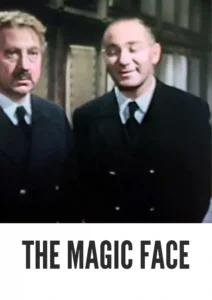Video Sources 0 Views

Synopsis

Enter the world of suspense and transformation with The Magic Face, a gripping psychological drama from 1951, now beautifully colorized for a mesmerizing viewing experience. Starring Luther Adler, this film delves into the dark recesses of the human psyche, exploring themes of identity, obsession, and the dangerous power of disguise. Perfect for enthusiasts of thought-provoking cinema and those seeking a unique, intense character study, this HD download brings a captivating and rarely seen film to your screen.
The Magic Face tells the story of Stefan Cameran (Luther Adler), a talented but tormented stage actor renowned for his uncanny ability to transform himself into different characters. Consumed by a burning hatred for Adolf Hitler and the Nazi regime, Stefan devises a daring plan to infiltrate the highest ranks of the Third Reich.
Using his mastery of disguise, Stefan meticulously transforms himself into Hitler, adopting his mannerisms, speech, and appearance with chilling accuracy. He successfully deceives those around him, gaining access to Hitler’s inner circle. However, as Stefan delves deeper into his impersonation, he begins to lose himself in the role, blurring the lines between his true identity and the persona he has created. His mental state deteriorates, and he becomes increasingly consumed by paranoia and madness.
The film follows Stefan’s descent into darkness as he struggles to maintain his sanity and carry out his mission. As the stakes rise, he finds himself caught in a web of deceit and danger, with his life and the fate of the world hanging in the balance. The Magic Face is a powerful and unsettling exploration of the corrupting influence of power and the devastating consequences of obsession.
The film features a compelling cast of actors who bring this intense story to life:
-
Luther Adler as Stefan Cameran / Adolf Hitler
-
Patricia Knight as Eve
-
William Conrad as Detective Agent Holliday
-
John Wengraf as Dr. Hauser
-
Ilka Grüning as Gretchen
The Magic Face falls into the genre of psychological drama, with strong elements of suspense, thriller, and film noir. Its dark and brooding atmosphere, combined with its exploration of complex psychological themes, makes it a captivating and unsettling cinematic experience.
Released in 1951, The Magic Face reflects the post-World War II fascination with psychological themes and the exploration of the human condition in the wake of unprecedented global conflict. The film was produced during a period when Hollywood was increasingly willing to tackle complex and controversial subjects, pushing the boundaries of cinematic storytelling. The Magic Face, while not as widely known as some of its contemporaries, offers valuable insights into the anxieties and preoccupations of the era, as well as the evolving landscape of American cinema.
This colorized version of The Magic Face has been carefully restored using modern digital techniques, enhancing the visual impact while preserving the film’s original atmosphere of suspense and intrigue. The colorization process involved meticulously analyzing the grayscale tones of the original black and white footage and assigning appropriate colors to each scene. While the specific software used remains proprietary, the techniques employed included advanced algorithms for color palette selection and image enhancement. This painstaking process breathes new life into the characters and settings, making the story even more engaging for modern audiences. While the artistic merits of colorizing classic films may be debated, it introduces these films to a broader audience, ensuring their preservation for future generations.
-
: Frank Tuttle
-
: Mort Briskin, Robert Smith
-
: Robert Thoeren
-
: Karl Struss
-
: Jamesද්ධStewart
-
: Columbia Pictures
-
: Columbia Pictures
-
: 88 minutes
-
: MP4
-
: HD (1080p)
-
: Compatible with most devices, including smartphones, tablets, computers, and smart TVs.
The Magic Face (1951) is a thought-provoking and unsettling film that explores the dark side of human nature and the corrupting influence of power. While it may not be considered a major classic, it remains a fascinating and disturbing example of post-war cinema and a showcase for Luther Adler’s powerful performance. As a relatively obscure but intriguing film, The Magic Face offers a unique perspective on the anxieties and preoccupations of the era.
-
: What is The Magic Face about?
-
A: The Magic Face is a psychological drama about an actor who impersonates Adolf Hitler.
-
-
: Is The Magic Face (1951) a well-known film?
-
A: The Magic Face is a relatively obscure film, offering a glimpse into post-war anxieties and psychological themes.
-
-
: Is this version of The Magic Face colorized?
-
A: Yes, this version has been professionally colorized to enhance the viewing experience.
-
-
: What makes The Magic Face interesting for film enthusiasts?
-
A: The Magic Face offers valuable insights into post-war cinema, showcasing the exploration of complex psychological themes and Luther Adler’s powerful performance.
-
-
: What is the download format?
-
A: The download format is MP4, which is compatible with most devices.
-
-
: What resolution is the download?
-
A: The resolution is HD (1080p), providing a high-quality viewing experience.
-
Watch The Magic Face Today!






